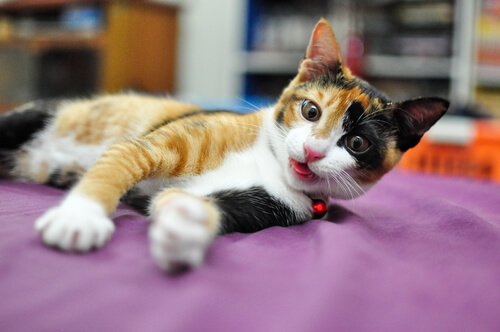Give Your Cat A Massage: how to do it


Written and verified by the lawyer Francisco María García
The Benefits of Knowing How to Give Your Cat a Massage
- Decrease the anxiety and stress of everyday life.
- Treat and prevent musculoskeletal diseases, such as arthritis, osteoarthritis, and dysplasia.
- Provide well-being and relieve pain in elderly animals, and in animals with terminal diseases.
- Prevent the negative effects of digestive, renal and hepatic tract problems.
- Promote lymphatic drainage and stimulate the immune system.
- Improve behavioral problems or emotional disorders.
- Help with weight management and assist in combating obesity-related diseases.
5 Risk-Free Steps to Give your Cat a Massage
Set Aside a Specific Time
Nowadays, people’s schedules are so full of responsibilities and obligations that, sometimes, has them forget to spend time on their pets.

In order to perform alternative therapy or have a relaxing time with your cat requires time and dedication. The first step to giving your cat a massage is to take the time out to spend quality time on the activity and enjoy it. Besides guaranteeing a good quality massage, it helps to improve the bonds of trust between pets and their owners.
How long can a good massage take? Well, it depends on the animal and on how much experience the person at giving it massages. If you are a beginner, you should give your cate a massage for 20 to 30-minutes. A more experienced person can perform the entire procedure in 10 to 15 minutes.
Prep your cat for the massage

Second, you need to help your pet relax so you can start giving them a massage. To do so, you can try talking, singing or simply keeping the animal company until they calm down and are willing to be massaged.
Choose an area to begin massaging
Correctly positioning your hands
Many people believe that you need to use your fingertips to provide a smoother, topical massage. This is incorrect and can cause anxiety and discomfort in cats and dogs.
Your fingertips are ideal for stimulating more sensitive regions, such as the head and face. When you give your cat a massage, it’s recommended that you use your entire hand to apply controlled pressure. This is especially true when you massage an animal’s back or belly.
Controlling your cat’s reaction
If you massage an animal, you must be attentive to their reactions. Since animals cannot verbalize whether they like being massaged, their attitudes reveal their true feelings.
If your cat tries to get up or is uncomfortable, they probably aren’t in the mood for a massage. However, if they are blinking, drooling or purring, those are all signs of pleasure.
When a cat attacks, scratches or bites you during a massage, it means that you are overstimulating them. If this happens, the best thing you can do is finish the massage and calm the animal down.
The Benefits of Knowing How to Give Your Cat a Massage
- Decrease the anxiety and stress of everyday life.
- Treat and prevent musculoskeletal diseases, such as arthritis, osteoarthritis, and dysplasia.
- Provide well-being and relieve pain in elderly animals, and in animals with terminal diseases.
- Prevent the negative effects of digestive, renal and hepatic tract problems.
- Promote lymphatic drainage and stimulate the immune system.
- Improve behavioral problems or emotional disorders.
- Help with weight management and assist in combating obesity-related diseases.
5 Risk-Free Steps to Give your Cat a Massage
Set Aside a Specific Time
Nowadays, people’s schedules are so full of responsibilities and obligations that, sometimes, has them forget to spend time on their pets.

In order to perform alternative therapy or have a relaxing time with your cat requires time and dedication. The first step to giving your cat a massage is to take the time out to spend quality time on the activity and enjoy it. Besides guaranteeing a good quality massage, it helps to improve the bonds of trust between pets and their owners.
How long can a good massage take? Well, it depends on the animal and on how much experience the person at giving it massages. If you are a beginner, you should give your cate a massage for 20 to 30-minutes. A more experienced person can perform the entire procedure in 10 to 15 minutes.
Prep your cat for the massage

Second, you need to help your pet relax so you can start giving them a massage. To do so, you can try talking, singing or simply keeping the animal company until they calm down and are willing to be massaged.
Choose an area to begin massaging
Correctly positioning your hands
Many people believe that you need to use your fingertips to provide a smoother, topical massage. This is incorrect and can cause anxiety and discomfort in cats and dogs.
Your fingertips are ideal for stimulating more sensitive regions, such as the head and face. When you give your cat a massage, it’s recommended that you use your entire hand to apply controlled pressure. This is especially true when you massage an animal’s back or belly.
Controlling your cat’s reaction
If you massage an animal, you must be attentive to their reactions. Since animals cannot verbalize whether they like being massaged, their attitudes reveal their true feelings.
If your cat tries to get up or is uncomfortable, they probably aren’t in the mood for a massage. However, if they are blinking, drooling or purring, those are all signs of pleasure.
When a cat attacks, scratches or bites you during a massage, it means that you are overstimulating them. If this happens, the best thing you can do is finish the massage and calm the animal down.
This text is provided for informational purposes only and does not replace consultation with a professional. If in doubt, consult your specialist.







